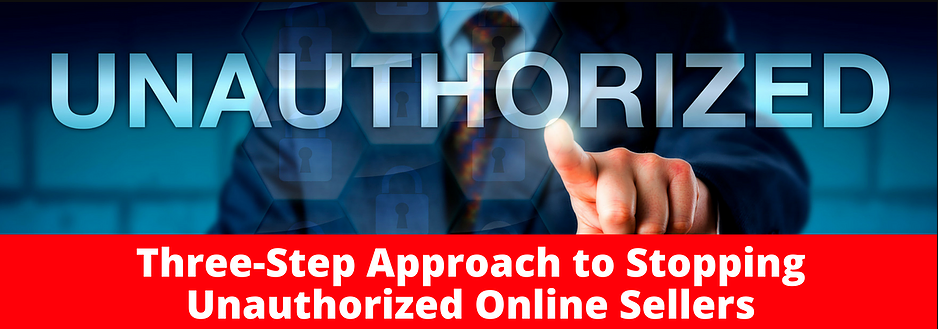Resources
Relevant Information and Actionable Takeaways

Unauthorized sales of products on third-party websites like eBay is significantly impacting many businesses.
In short, we recommend a three-step program for addressing these unauthorized sellers as follows, with more details listed below.
First, a company should revise its policies, procedures and agreements to: 1) support legal claims against third-party unauthorized sellers, and 2) differentiate its products from those sold by unauthorized sellers.
Second, a company should implement a graduated enforcement system. The purpose of this system is to eliminate authorized sellers through the integration of monitoring technology, investigation, and enforcement tactics.
Third, we recommend implementing a communications strategy that:
1) demonstrates to authorized distributors that the company is protecting them (providing measurable results from the enforcement system)
2) demonstrates that products sold by unauthorized sellers are unreliable and often do not come with certain services and benefits or do not have the quality controls that the company has established.
Creating a Foundation for Legal Claims Against Third-Party Unauthorized Sellers
Our recommended first step for companies is working with counsel to review existing distributor agreements, procedures and practices. The goal is to provide the best support possible for the enforcement program, described in step two.
Under what is known as the First Sale Doctrine, once a trademark owner (“the company”) sells a product, the buyer ordinarily can resell the product without infringing the owner’s mark. However, the First Sale Doctrine does not apply when a reseller sells a trademarked good that is materially different from the company’s genuine goods.
Case law has established a few important principles relating to material differences. This includes that:
1) The threshold of materiality is considered “low”
2) Only a single material difference is necessary to give rise to a trademark infringement claim
3) Material differences do not have to be “physical” differences.
Courts have also held that trademark owners have the right to control the quality of their products. Thus, unauthorized sellers who do not follow a company’s quality controls can also commit trademark infringement, assuming the quality controls are not “pretextual” and that the company is actually enforcing them. Quality controls can include certain packaging, tracking codes, pre-sale consultations or storage instructions, among others.
Many companies already have strong policies, procedures and agreements established. It is just a matter of tweaking them to maximize protection against unauthorized sellers on eBay and other websites.
The Graduated Unauthorized Seller Enforcement System
Once a company’s policies, procedures and agreements are adequately in place, it is time to roll out a graduated enforcement system aimed at efficiently and effectively reducing the numbers of unauthorized sellers.

Our suggested model begins with a monitoring company finding all unauthorized sellers. Among other things, a monitoring company can rank these sellers from high- to low-volume, based on the number of client products and total products each reseller is selling.
Cease and desist letters are usually sufficient for most unauthorized sellers. However, a more aggressive enforcement approach might be necessary for sellers offering a significant number of products.
After reviewing the data from the initial monitoring report, it is ultimately up to the company who to target through the enforcement system. But because both eBay allow for the private messaging of their online sellers, this can be a low cost vehicle for sending a large number of cease and desist letters online (“eC&Ds”).
A strongly-worded letter from an outside law firm is often most effective in approaching the highest volume sellers, which might include a detailed explanation of the illegality of the seller’s activity and why the First Sale Doctrine would not apply; an explanation that courts in the company’s state will have jurisdiction over the seller; and relevant case law, including citations to prior cases in which large damages have been awarded against unauthorized sellers.
The company itself might also choose to send additional eC&Ds to low volume sellers.
After the letters are sent, the company and its enforcement team should track which sellers comply with their demands. Then, cyber investigators can investigate the identities of any sellers who do not remove the products from eBay.
Once these identities are obtained, the outside law firm can send actual cease and desist letters to the unauthorized sellers’ physical addresses, effectively communicating that: 1) the company knows who they are and where they are and, 2) should they keep engaging in unauthorized sales, that the company will pursue them legally.
This whole process can be repeated on a monthly basis, incorporating any new sellers that pop up each month. If necessary, for any sellers still online after the previous month, the attorneys can utilize additional legal tactics to put further pressure on those sellers.
Depending on the situation, this can entail sending draft complaints to the sellers; obtaining temporary restraining orders to freeze online sellers’ PayPal accounts; obtaining injunctions to order online sellers to cease selling the products; obtaining injunctions ordering the transfer of the sellers’ website domains to the client; serving subpoenas to identify still unknown sellers; obtaining court orders that can be used to de-index unauthorized sellers’ e-commerce websites from Google; filing lawsuits and negotiating with the sellers; or preparing and executing settlement agreements.
Above is an illustration of how we often structure our own graduated enforcement program.
Communications Strategy
For some companies, depending on their model and distributor network, it can be effective to communicate to the authorized distributors the impact of the enforcement program.
It is helpful to educate (or remind) distributors that the company has an aggressive enforcement program. Specifically, the company can show them the data reflecting the number of unauthorized sellers eliminated from eBay (or elsewhere) and are no longer harming the business and threatening the authorized distribution channels.



